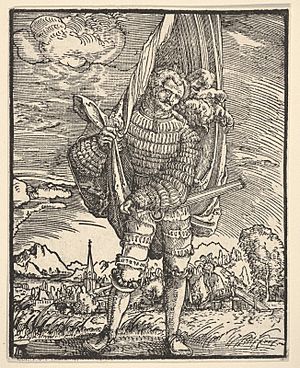William Parker, 9th baron Morley facts for kids
Sir William Parker (around 1465 – 1510) was an important English nobleman. He served as a trusted advisor to King Richard III and carried the king's special flag, known as the standard.
Quick facts for kids
William Parker
|
|
|---|---|
| 9th baron Morley | |
 |
|
| Born | c. 1465 |
| Died | c.1510 |
| Noble family | Baron Morley |
| Spouse(s) | Alice Parker, 9th Baroness Morley |
| Mother | Agnes Parker |
| Occupation | Privy councillor and standard-bearer to Richard III |
Life and Family
Sir William Parker was the father of Henry Parker. He was married to Alice Lovel (around 1467–1518). Alice was the 9th Baroness Morley in her own right. Her mother, Alianore Lovel, was the 7th Baroness Morley.
William Parker was connected to the royal family. His wife's brother, Henry Lovel, was married to Elizabeth de la Pole. Elizabeth was a niece of two kings: Edward IV and Richard III.
Inheriting Estates
Most of Sir William's wealth came from his wife, Alice. She inherited it from her brother, Henry Lovel. When Alice's parents, Alianore and William Lovel, died in 1476, Henry was only 10 years old.
Because Henry was so young, his family's lands were managed by others. Some estates went to guardians, some to other nobles, and some stayed with King Richard III. Some lands were also given to Sir Francis Lovel. This happened even though Henry's great-grandfather had made different plans for the estates.
Henry Lovel died in a battle in Flanders in 1489, when he was 23. After his death, his sister Alice Lovel and her husband, William Parker, inherited his noble titles. They also received most of his properties. These included large estates in places like Great Hallingbury (Essex) and Walkern (Hertfordshire). They also gained lands in Hingham, Buxston, and Morley Hall in Norfolk.
Service to the King
Sir William was a strong supporter of King Richard III. He became well-known during the English invasion of Scotland (1482). Richard III made him a knight on July 24, 1482.
He was also rewarded for helping to stop a rebellion in October 1483. This was called Buckingham's rebellion.
Sir William became Richard III's standard-bearer. This meant he carried the king's personal flag into battle. He fought alongside Richard III on August 22, 1485. This was at the Battle of Bosworth. They fought against Henry Tudor.
Henry Tudor won the battle and became King Henry VII. Because Sir William was so loyal to Richard III, Henry VII did not favor him. Family stories say that Sir William was held as a "king's prisoner" after the Wars of the Roses. The Wars of the Roses were a series of civil wars fought in England.
Later Life and Death
Sir William Parker faced health challenges later in his life. He died around 1510. He was buried in the church of St. Gilles in Great Hallingbury. His wife Alice, his son Henry, and other family members were also buried there.
After Sir William's death, his widow Alice Lovel remarried quickly. She married Edward Howard. He was a British naval officer. To make sure Alice's son, Henry Parker, would still get his inheritance, a powerful lady named Margaret Beaufort paid Edward Howard a sum of money. Sir Edward Howard died in a sea battle in 1513. Alice Lovel died five years later.


